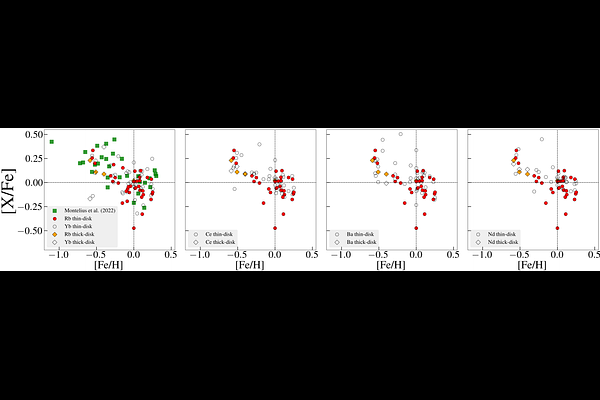Rubidium Abundances in Cool Giants from High-Resolution H-band Spectra: A New Diagnostic for Galactic Chemical Evolution

Rubidium Abundances in Cool Giants from High-Resolution H-band Spectra: A New Diagnostic for Galactic Chemical Evolution
Nils Ryde, Jess Kocher, Govind Nandakumar, Henrik Hartman, Marta Molero, Henrik Jönsson, Gregory Mace, Erica Sawczynec, Kyle F. Kaplan
AbstractThe Galactic Center and inner disk of the Milky Way contain complex stellar populations obscured by heavy dust extinction. To study their chemical composition, high-resolution near-infrared (near-IR) spectroscopy is necessary. Expanding the set of elements measurable in the near-IR, especially neutron-capture elements, improves our ability to trace nucleosynthesis and Galactic chemical evolution. This work aims to identify and characterize a spectral line suitable for determining rubidium (Rb) abundances. Rb is produced in roughly equal parts by the r- and s-processes. We analyze high-resolution (R = 45,000) IGRINS near-IR spectra of 40 M giants in the solar neighborhood, most observed with Gemini South. We perform spectral synthesis of the Rb I line at 15289.48 A, using new log(gf) values and including an astrophysical calibration of the blending Fe I lines. The resulting [Rb/Fe] ratios are compared to other neutron-capture elements and interpreted with chemical evolution models. We demonstrate that the used Rb line is a reliable abundance indicator in M giants and the coolest K giants, but becomes too weak at higher temperatures. [Rb/Fe] shows a decreasing trend with metallicity, mirroring that of ytterbium (Yb), another mixed r-/s-process element. Our results agree with optical studies, validating the use of this near-IR line. Comparisons with chemical evolution models confirm that both s- and r-process sources are needed to explain the Rb trend. This work adds Rb to the list of elements measurable in high-resolution H- and K-band spectra, enabling studies of one more neutron-capture element in dust-obscured regions like the Galactic Center and inner disk.